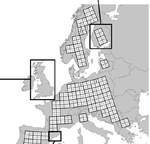Abstract
Aim We test the prediction that beta diversity (species turnover) and the decay of community similarity with distance depend on spatial resolution (grain). We also study whether patterns of beta diversity are related to variability in climate, land cover or geographic distance and how the independent effects of these variables depend on the spatial grain of the data.
Location Europe, Great Britain, Finland and Catalonia.
Methods We used data on European birds, plants, butterflies, amphibians and reptiles, and data on British plants, Catalonian birds and Finnish butterflies. We fitted two or three nested grids of varying resolutions to each of these datasets. For each grid we calculated differences in climate, differences in land-cover composition (CORINE) and beta diversity (βsim, βJaccard) between all pairs of grid cells. In a separate analysis we looked specifically at pairs of adjacent grid cells (the first distance class). We then used variation partitioning to identify the magnitude of independent statistical associations (i.e. independent effects in the statistical sense) of climate, land cover and geographic distance with spatial patterns of beta diversity.
Results Beta diversity between grid cells at any given distance decreased with increasing grain. Geographic distance was always the most important predictor of beta diversity for all pairwise comparisons at the extent of Europe. Climate and land cover had weaker but distinct and grain-dependent effects. Climate was more important at relatively coarse grains, whereas land-cover effects were stronger at finer grains. In the country-wide analyses, climate and land cover were more important than geographic distance. Climatic and land-cover models performed poorly and showed no systematic grain dependence for beta diversity between adjacent grid cells.
Main conclusions We found that relationships between geographic distance and beta diversity, as well as the environmental correlates of beta diversity, are systematically grain dependent. The strong independent effect of distance indicates that, contrary to the current belief, a substantial fraction of species are missing from areas with a suitable environment. Moreover, the effects of geographic distance (at continental extents) and land cover (at fine grains) indicate that any species distribution modelling should take both environment and dispersal limitation into account.
